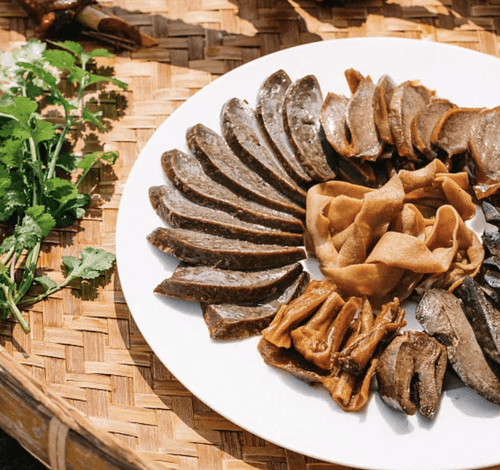
Chaoshan ‘Kung Fu’ Dishes – The Art of Time, Tradition, and Technique
Beyond raw freshness, the soul of Chaoshan cuisine lies in its "Kung Fu"—the mastery of complex, time-consuming techniques. This craftsmanship transforms humble ingredients into elegant banquet dishes, carrying centuries of history and tradition. These six dishes embody the region’s deep culinary heritage.
Marinated Goose (Lu E): The Legacy of the Hundred-Year Broth
The Star Ingredient: The Majestic Lion-Head Goose
Chaoshan uses the Lion-Head Goose, China's largest goose breed, famed for its rich, substantial meat that serves as the perfect canvas for the marinade.
The Technique: The Immortal "Lao Lu" (Old Broth)
The goose is cooked in the "Lao Lu" (Old Broth)—a flavorful master stock that is continuously used, refined, and replenished over years, sometimes even decades. This complex liquid, infused with dozens of Chinese herbs and spices, is the heart of the dish. The process requires slow simmering, allowing the rich, fragrant marinade to deeply penetrate the meat.
Cultural Symbolism: The Lu E is the absolute centerpiece of any Chaoshan feast ("No Goose, No Feast"), signifying prosperity and reverence for tradition.
Fish "Rice" (Yu Fan): The Ingenuity of the Fishermen
The Heritage: The Shipboard Preservation Method
The name "Fish Rice" is historical; it was a substitute for rice on long fishing trips. Lacking refrigeration, fishermen developed this technique to preserve their catch: they would steam or boil whole fish (un-gutted and un-scaled) directly on the boat using saltwater, then let them cool.
The Flavor Profile: Salt and Texture
The process results in fish that is firm, savory, and incredibly fresh when served cold. The salt water locks in the moisture and flavor. Served cold, often with a dipping sauce of Puning Fermented Bean Paste, it's an essential item on any traditional Teochew dinner table.
Patriotic Soup (Hu Guo Cai): A Dish that Saved a Dynasty’s Soul
The Heritage: A Royal Endorsement
This dish dates back to the late Song Dynasty. Legend says the last Song Emperor, fleeing invasion, was served a hastily prepared soup by monks using only sweet potato leaves and high-quality broth. The Emperor loved the simple, pure flavour and named it "Nation-Protecting Dish."
The Technique: The Refinement of Simplicity
It is a classic example of "Vegetarian Dish Cooked in a Meat Style." The key is the clear, rich Gao Tang (supreme stock) used to elevate the humble sweet potato leaves. The result is a smooth, velvety soup, delicate in flavor and highly refined—a testament to elegance found in simplicity.
Charcoal Roasted Whelk (Ming Lu Shao Xiang Luo)
The Ingredient Check: This dish demands the largest, most expensive whelk (conch), prized for its thick, crunchy meat.
The Technique: The Precision of the Hearth
The traditional method involves roasting the whole whelk slowly over an open charcoal flame (Ming Lu). Crucially, not a drop of water is added. The chef's Kung Fu is in controlling the heat to cook the meat perfectly in its own juice, resulting in a unique tender-crisp texture and intensified oceanic flavour.
The Status: This is a signature dish of high-end Chaoshan banquets, showcasing the chef's skill and the host's generosity.
Fish Dumplings (Yu Jiao)
The Technique: The Ingenuity of the Fish Skin
Chaoshan elevates the dumpling by replacing the flour wrapper with fish paste. Skilled artisans scrape the fish meat, pound it with tapioca starch, and roll it into paper-thin "fish skin" to wrap the savoury pork or shrimp filling.
The Texture: The fish skin is springy and smooth, providing a unique bounce that perfectly complements the flavourful filling. It's a smart, delicious way to maximize the bounty of the sea.
Fried Meat Roll (Zha Guo Rou)
The Technique: Layering Texture
This traditional snack features cubed pork belly, diced water chestnuts (for a fresh crunch), and taro, all seasoned and tightly wrapped in a thin layer of dried bean curd skin (Fu Pi). It is then deep-fried until golden.
The Flavor Profile: The crispy exterior gives way to a savoury, juicy filling, balanced by the sweetness and crunch of the water chestnuts. It’s an essential, robust flavour often found alongside the subtle elegance of the Lu E.


